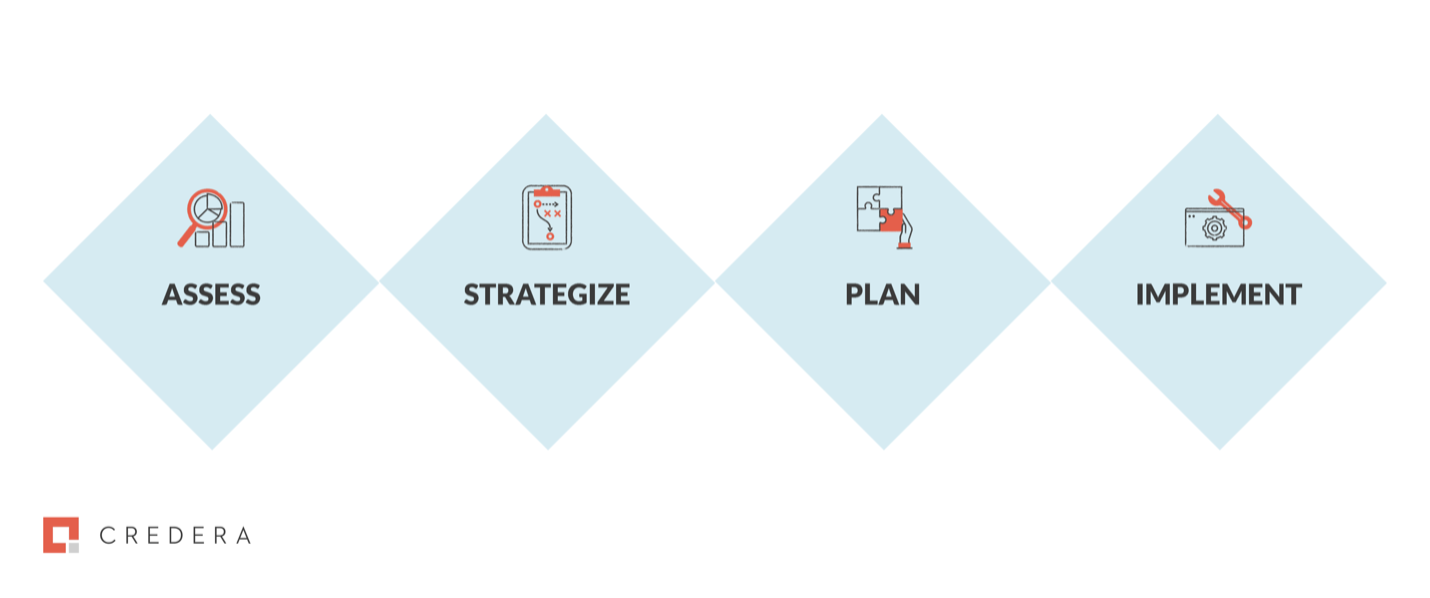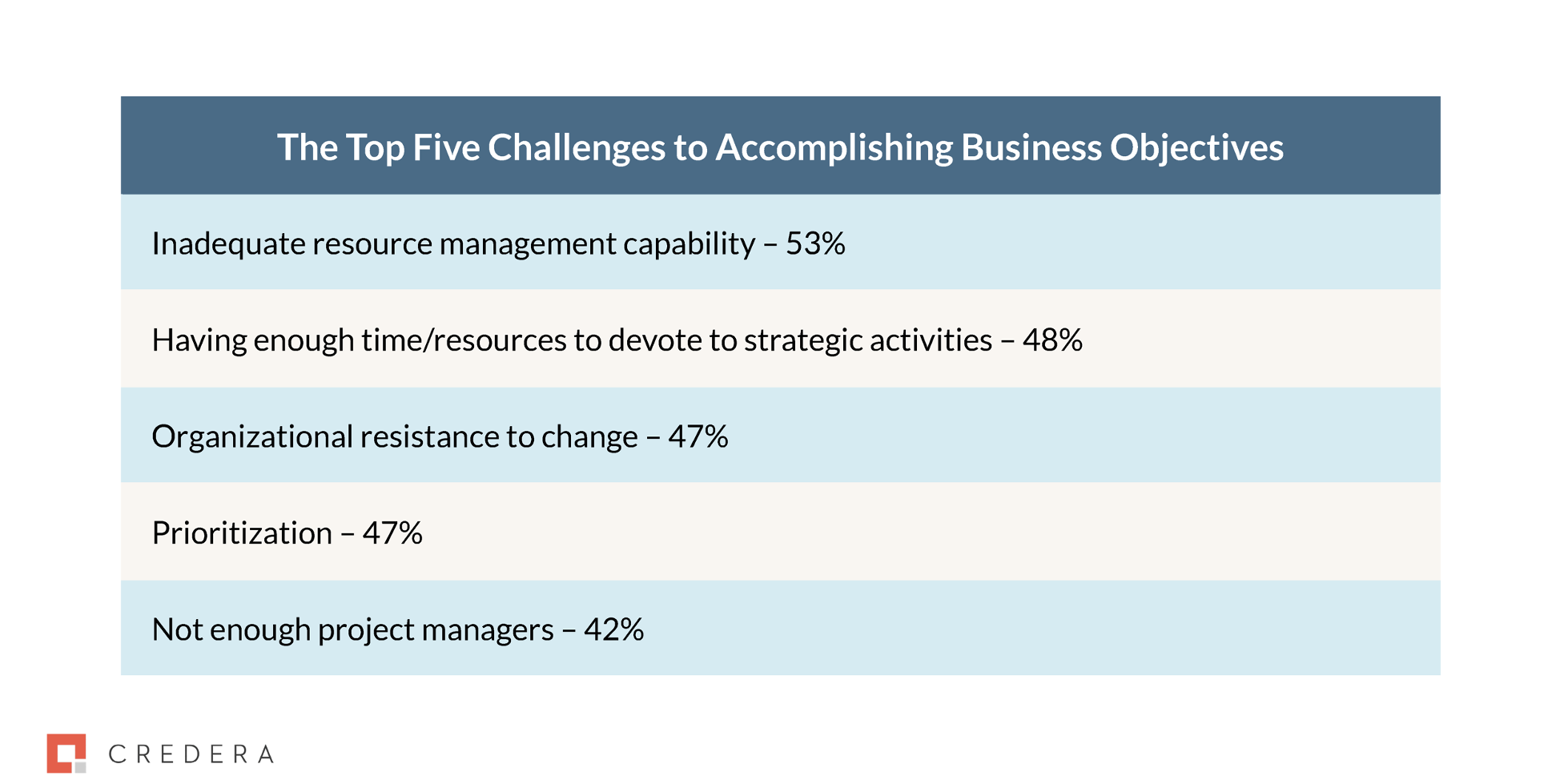Transformation
Aug 11, 2022
4 Steps to Improve Your Project Management Office & Why It Might Not Be Keeping Up

The traditional role of a project management office, or PMO, is to define and maintain standards for project management throughout an enterprise. Those standards need to be the same across activities like project cost estimation, detailed project planning, resourcing, training, and project execution. 71% of organizations have a PMO, so there’s clearly value in maintaining governance—centralized oversight and decision making—to project management. Yet as organizations continue to evolve and refocus their goals, the PMO must also evolve in order to maintain efficacy, relevance, and value to the business.
What Are the Challenges Impeding Business Objectives Today?
The challenges facing organizations have not changed much despite new norms in how organizations engage their teams.Organizations continue to be plagued by inadequate resource management, both human and financial, and too few effective project managers. Furthermore, most organizations still face heavy resistance to change, which is an impediment to the successful implementation of any new idea, initiative, project, or massive transformational program that we see so often today.
Some of these challenges, however, have compounded effects across organizations. Today, teams are increasingly distributed across geographies, putting a greater burden on organizations to manage their teams, and to plan and deliver business and IT projects effectively. For example, at Credera, we are seeing an increased need from the organizations we partner with to support them in planning and implementing better standardized practices, organization, and governance across geographically diverse engineering, technology, marketing, and vendor delivery workstreams.
What Does an Effective PMO Look Like Today?
The Project Management Institute defines PMO as an organizational structure that may be used to standardize the portfolio, program, or project-related governance processes and facilitate the sharing of resources, methodologies, tools, and techniques. From Credera’s perspective, an effective PMO provides improvements to program visibility, cross-team planning, collaboration, and flexibility.

An effective PMO team should provide clear processes, chains of command, and the tools to get the job done, but also flexibility at the team level to allow them to operate autonomously toward a unified goal. Low performing PMOs do just the opposite, becoming a bottleneck for productivity if autonomy is not granted.
Rapid feedback, knowledge sharing, and top-down direction can help mitigate productivity bottlenecks. Coincidentally, adoption of agile PMO structures and roles can do all of that at once. This is perhaps why 70% of organizations now deploy some form of agile processes throughout their enterprise, and why modern PMOs and improvements typically drive toward a culture of continuous improvement to reach the target maturity for the PMO organization.
Agile and hybrid agile PMOs provide flatter, global team structures that provide more autonomy to and collaboration between their teams. This provides more flexibility as they consider becoming more digital, customer centric, or data driven through agile, cloud, enterprise resource planning (ERP), customer relationship management (CRM), etc.
How Could You Improve Your PMO?
Whether your PMO is in its infancy and looking to grow, or mature and looking for new ways to optimize, consider this approach: assess, strategize, plan, and implement.

PMO Improvement Approach
PMO Improvement 1: Assess
In this phase, the goal is to clearly define the desired end state of your PMO, such as implementing agile or providing oversight to development efforts. This creates a vision that informs all future steps in the PMO process. This vision, the “North Star,” also plays to an additional goal of this phase: to assess the current capabilities of your PMO and identify areas of opportunity within your current project management ecosystem to enable the desired future state.
Wait, is this just a gap assessment? Yes, but it is important to holistically assess and measure PMO capabilities across people, process, and technology to clearly define current and desired maturity. This can only be done with a good understanding of the desired future state and PMO best practices. Wherever you source this knowledge, consider it requisite to enabling a more robust and accurate gap assessment. This is a necessity to clearly determine the change needed between current and desired maturity.
PMO Improvement 2: Strategize
By being realistic in the prior phase on what can be accomplished in a specific time frame, it becomes easier to align your PMO solution with your organization’s maturity goals and initiatives. The goal of the strategize phase is to develop a framework for the proposed PMO governance and organization structure, standardized PMO definitions, and a register of prioritized initiatives that will enable the move toward future state maturity. Think about what initiatives and activities will make the largest impact and then prioritize those initiatives by business impact and the value generated.
One last takeaway for this phase: When defining the structure and responsibilities of your PMO and when prioritizing initiatives, be realistic about the level of responsibility your future PMO will adopt. Just as we learn to walk before we learn to run, it is important to be realistic about the target level of maturity for your PMO and to remember there’s always room for growth.
PMO Improvement 3: Plan
In the plan phase, the goal is to quantify the roadmap and understand the timeline and resources required for PMO implementation. Often, the proposed PMO plan will require a culture of continuous improvement to reach the target maturity for the PMO organization. Ensure your organization is ready for this change. Consider all affected stakeholders and ensure dependencies and change activities are understood and planned for within the roadmap.
During this phase, defining formal communication channels between each layer of the operating structure makes it easier to communicate the value the desired change will bring to all impacted stakeholders. As business conditions change or as decisions are made, these channels can be leveraged to allow efficient communication to all roles within the operating model. In a fluid and rapidly evolving business world, an effective communication strategy is critical to realizing PMO transformation return on investment (ROI).
PMO Improvement 4: Implement
In the plan phase, we mentioned realizing transformation ROI. When implementing your PMO roadmap, this ROI is measured by adoption, change effectiveness, and financial return. To support these ROI levers, there are several actions that could be taken during project kickoff and through implementation:
1. Promote Adoption by the Organization:
Clearly communicate the value proposition and the reason for change to all stakeholders and impacted teams. Clarifying your organization’s goals, vision, and mission. Demonstrating leadership support for these objectives is important to creating buy-in and support for the new structure.
Ramp up resources and acquire the tools needed to reach the target state. This is important for successful day-to-day implementation activities, and a necessity for the successful operation of the target state PMO.
Establish the formal communication channels defined in the prior phase, e.g., between each layer of the operating structure from executive leadership to steering committee to program leadership to the individual workstreams. A well-defined communication structure helps promote visibility on status, alignment with business objectives, and responsiveness to change.
2. Promote Change Effectiveness and Flexibility
Provide effective training that is tailored to the needs of the users in the new PMO organization. Proper training allows users to understand updated procedures and apply them in their everyday work.
Implement status reporting, including issue, budget, metric, and resource management tracking. Metrics or key performance indicators (KPIs) tracked by the PMO should be relatable to stakeholders and are essential for establishing baselines for the future.
Establish a process for change management, conflict resolution, and resolving project blockers. The goal here is to provide both structure and flexibility as issues arise or business needs change.
3. Demonstrate Value Early and Build Momentum for Strategic Initiatives
Lastly, start by investing in the quick wins and strategic initiatives on your roadmap that will have the biggest value. This will help the implementation team identify gaps or issues in their structure or communication lines early on, while also helping build momentum and confidence before taking on larger initiatives.
What Is the State of Your PMO?
Could your PMO provide greater value to your organization? Ask yourself these questions:
Is your PMO aligned to your organization’s strategy?
Is your PMO high-performing, mature, and optimized?
Are you able to prioritize projects and resources effectively?
Do you have the tools, training, and structure needed to operate in an agile way?
If you answered “no” to any of these, it could be time to rethink your PMO. There is no one-size-fits-all standard for implementing the “best PMO.” It depends on your organization’s culture, circumstances, and appetite.
Some organizations might rely on more strategic PMOs, others more operational and execution focused. Some organizations rely on multiple PMOs with different strategic objectives, while others struggle to operate without a PMO. In any case, it is important to find the right PMO for your organization to unlock immediate efficiencies and benefits while aligning your teams toward a shared “North Star.”
Are you looking for the right PMO to fit your organization’s needs and goals? Reach out to us at marketing@credera.com to start a conversation.
Contact Us
Ready to achieve your vision? We're here to help.
We'd love to start a conversation. Fill out the form and we'll connect you with the right person.
Searching for a new career?
View job openings






